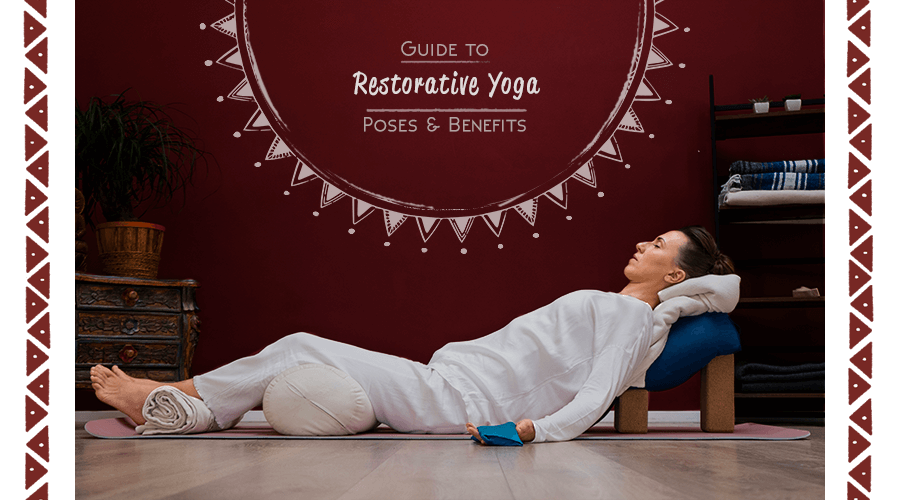What is Restorative Yoga?
The practice of Restorative Yoga can be defined as a yoga practice in which we support the body to such an extent that we feel safe enough to completely relax the body and mind. The postures are restful and are held for a long time in order to release mental and emotional tensions.
Our mind is constantly busy mulling over future and past actions. We are exhausted by thinking about what we could have done or will do. This disconnection with the present often prevents us from truly practicing yoga, and therefore often reduces the discipline of yoga to mere physical exercise.
Read more: Yin Yoga versus Restorative Yoga – What Are the Differences and Similarities?
Yoga is so much more than just the physical shapes we assume during practice. In a true yoga practice, we connect with our innermost Self - our true Self. Yoga asanas and breathing exercises, performed in a state of mental and physical equanimity are the backbones of the ancient yoga tradition that guides us on the way to reconnecting with our spirit.
Restorative Yoga allows us to truly stop. Thanks to the use of supports, we are able to completely relax every cell of our body and to nudge it into the state of parasympathetic nervous system arousal. Restorative Yoga provides precisely the right kind of physical and mental activation that allows us to enter a deeply relaxed state.
What is the purpose of Restorative Yoga?
Restorative Yoga primarily seeks to let the body enter into a state of rest and relaxation and activate the parasympathetic nervous system more easily. As the word ‘restore’ connotes, Restorative Yoga seeks to bring the body and mind to a natural state of calmness and harmony by gently and mindfully allowing the body to move between movement and stillness.
Restorative Yoga is often regarded as active relaxation because the poses do not involve too much stretching and straining. Moreover, as we hold the poses for longer duration, the body gets enough time to drop into a state of complete relaxation. The mind slows down, the breathing deepens, and the bodily functions get balanced.
Restorative Yoga nourishes and soothes the body and mind. As such, a regular practice not only heals and strengthens a weak and tired body but also brings about deep emotional healing. Thus, Restorative Yoga becomes more of a therapeutic yoga style than simply a fitness oriented practice.
How to practice Restorative Yoga
Restorative Yoga focuses on two main points: letting go and grounding.
In the practice of Restorative Yoga, props are essential to reach our goal. When we say props, we also mean simple props that you can find in your own home. They do not need to be special yoga props.
How to do Restorative Yoga at home?
Common props that you will need for the practice of Restorative Yoga at home:
- One yoga mat
- One bolster or two rolled blankets
- One chair
- Three to five blankets or towels
- One trouser belt or bathrobe belt
- Two yoga bricks or two fairly large books
- One eye pillow of 15 or 150 grams or a small hand towel
For how long do we hold poses?
Restorative Yoga poses are held for five to 30 minutes, and the final relaxation in Shavasana is up to 25 minutes.
Who should do Restorative Yoga?
The biggest plus of Restorative Yoga is that it can be adapted to everyone, regardless of age and experience. The use of many supports allows everyone to practice the postures. There are seemingly infinite variations for each pose which makes sure that everyone can experience relaxation in each pose.
Restorative Yoga and the nervous system
Relaxation is the solution to truly rest and to reactivate the physiological functions of the body. Relaxing does not mean sleeping. In fact, if sleep is disturbed, we do regenerate at all, but we feel even more exhausted.
During sleep, there are dreams and other stages that can create muscle and mental activation. Relaxation is the time when there is no physical or mental effort, and the mind is completely calm.
In the practice of Restorative Yoga, the relaxation is “active.” And through the mindful performance of the postures and the focus on the breath, we quickly enter a parasympathetic state.
What happens when the parasympathetic nervous system is activated?
The autonomic nervous system is responsible for regulating the body's unconscious actions.
The parasympathetic system is responsible for "rest and digestion" responses, which are all activities that occur when the body is at rest, including sexual arousal, salivation, lacrimation, urination, digestion, and defecation.
The action of the parasympathetic nervous system is complementary to that of the sympathetic nervous system, which is responsible for the activities associated with the "fight or flight" response.
When we are in a state of relaxation and tranquillity, and consequently, when our mind is calm, our nervous system enters the parasympathetic state.
Benefits of Restorative Yoga
Improves digestion
When the body is under stress, non-essential functions such as digestion, cell reproduction, intestine, and cell growth are blocked. Restorative Yoga, by rebalancing the nervous system, helps digestion to perform its basic functions and the intestine to absorb nutrients and generate waste material.
Improves memory, concentration, and mental clarity
There are countless scientific studies that show how the balance of the nervous system and a witty and tamed mind leads to stages of deep concentration that cannot occur in stages of agitation and anxiety.
Regulates blood pressure
Stress states cause blood pressure to rise and interfere with its balance; states of relaxation slow down the heartbeat and regulate blood pressure to healthy levels.
Supports women during pregnancy, menopause, and menstruation
Restorative Yoga, with all its modifications and variations, is an excellent practice to rebalance the entire female hormonal system. This is especially true in so-called altered stages, such as moments of hormonal change like adolescence, pregnancy, and menopause.
Helps with managing endometriosis
Restorative Yoga helps in pain management and hormonal balance. It helps women to regain physical and mental peace, activates hormonal rebalancing, and reduces the perception of pain. For years now I have been part of a research group that works closely with women who suffer from endometriosis and with women from all over Lombardy who decided to combine medical treatment with a path of Restorative Yoga and therapeutic Yoga to alleviate the situation.
Supports the body during periods of grief
Restorative Yoga helps after major trauma, such as the loss of a loved one or after an accident or illness.
Supports in case of trauma
Practicing Restorative Yoga helps in case of physical trauma, but also of psychological trauma. When practiced regularly, it induces a process of self-healing and awareness of our reactions to the difficulties of life. I find the practice of Restorative Yoga to be of great support for rehabilitation therapies of all kinds and as a support to mental professionals, such as psychologists and therapists.
Helps to lose weight
Restorative Yoga teaches us how to become more aware, and it lessens the need to overeat. Regular practice, even just for 20 minutes a day, increases the awareness of our actions, teaches us to love ourselves, reduces the need to compensate for the malaise of modern life with food or "junk food." It is a great starting point to redefine our eating and lifestyle habits.
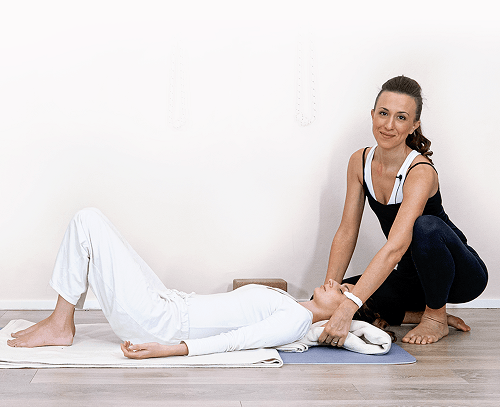
Get our Restorative Yoga e-book for free
Feel more calm and relaxed with our e-book containing 3 Restorative Yoga sequences
Popular Restorative Yoga poses
Setu Bandha Sarvangasana
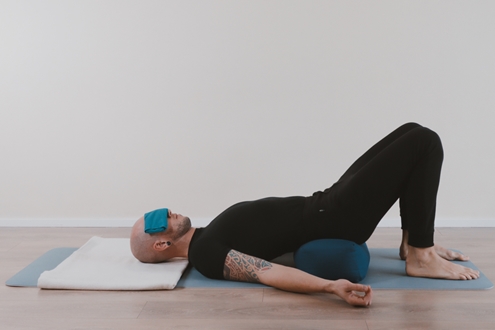
Hold for: 5-15 min
Benefits:
- Releases tension in the lower back and brings heavy heart rejuvenation.
- Helps prevent arterial blockages or cardiac arrest by resting the heart muscles and increasing blood circulation in the arteries.
- It soothes the brain and opens the chest by stabilizing blood pressure, helps fight hypertension and depression.
- Relieves eye or ear ailments, migraines, stress-related headaches, nervous exhaustion, and insomnia.
- It improves digestion and strengthens the abdominal organs. Relieves back pain, strengthens the spine, and relieves neck tension.
- Helps rest tired legs and prevents varicose veins.
Cautions:
Do not practice if you suffer from:
- spondylosis
- spondylolisthesis
- discopathies
- high blood pressure
- if you are pregnant for more than three months
Viparita Karani
Hold for: 5-15 minutes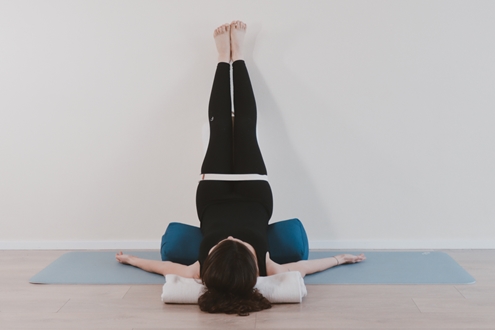
Benefits:
- Relieves anxiety.
- Relieves digestive problems.
- Helps with migraines, depression, menstrual cramps, varicose veins.
- Helps in the menopause stage.
- Regulates blood pressure.
- Helps relieve arthritis.
Cautions:
Do not practice in case of:
- eye problems
- heart problems
- hiatal hernia
- high blood pressure
Supta Baddha Konasana
Hold for: 10-15min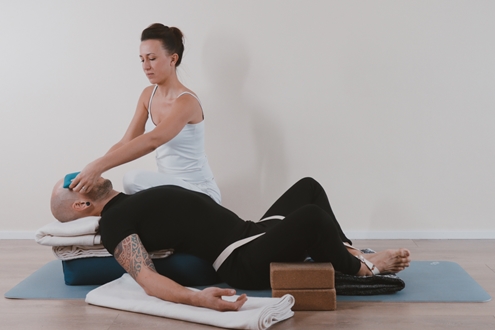
Benefits:
- Regulates blood pressure.
- Helps during menstruation and menopause.
- Prevents hernia.
- Relieves back pain in the lumbar area, varicose veins, and sciatica.
- Reduces the pain caused by hemorrhoids.
- Relieves indigestion and flatulence.
- Corrects uterine prolapse.
Cautions:
Do not practice in case of:
- spondylolisthesis or spondylolysis.
- discomfort in the neck or lower back even after varying the height and positioning of the supports.
How Restorative Yoga benefits every kind of student
Below you can find an overview of how the practice of Restorative Yoga practice can fit every kind of yoga student.
Healthy and active students
The practice of Restorative Yoga helps our body's tissues to regenerate, and therefore, will help the active student to experience better performance and to maintain an active life without getting tired.
Stressed and hypertensive students
From the very first lesson onward, will help re-educate the body and mind to a state of relaxation.
Students with specific conditions
For special situations, a teacher needs to make a personal assessment and understand what poses will help the student in his/ her process. As the holding times of the poses are long you have sufficient time to assist students individually.
Anxious students
Restorative Yoga will make their mind stronger and more rational through the practice of observation and detachment. Restorative yoga, combined with Yoga Nidra, can greatly reduce anxiety and panic attacks.
Student recovering from an illness
Restorative Yoga will aid in the student's recovery because, during the practice of Restorative Yoga, the body activates the healing processes.
Restorative Yoga for teachers.
Yoga teachers get exhausted too
Even yoga teachers often get tired. This is especially true in the world of online teaching. Many yoga teachers practice a lot. Not in silence, though, but they practice along while teaching online classes, often with little attention and introspection. Restorative Yoga is ideal for helping a teacher's body regenerate and "heal." More and more often, teachers experience chronic pain in the back and leg ligaments and shoulders problems. Therefore, it's an ideal practice for those who teach modern dynamic yoga.
Yoga teachers lose their personal practice
The second reason is a little more delicate to admit, but I know that it happens often and to almost all teachers. Yoga teachers lose their personal practice, or in any case, lose its quality. By teaching a lot, teachers identify with the teaching and lose their healthy routines. Teachers start to put students and classes first, and so we also have a lot of stressed yoga teachers, overburdened with rent, too many online and live classes, and too many projects. Restorative Yoga helps teachers take quality time for themselves and remember why they became yoga instructors.

Get our Restorative Yoga e-book for free
Feel more calm and relaxed with our e-book containing 3 Restorative Yoga sequences

